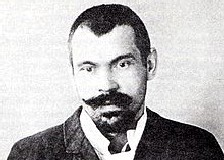Frans Otto Eriksson (15 April 1867 – 7 June
1953), also known as Svarta Hästen ("The Black Horse"), was a
Swedish baker and a convicted thief and murderer.
Initially involved in petty crimes between baking
jobs, Eriksson joined a conspiracy to commit double murder in
desperation for money. Despite being caught, he escaped the death
penalty and was sentenced to life imprisonment, of which he served
nearly 21 years.
Early life
Eriksson was born in Badelunda, Västerås. His
family moved to Stenby, Adelsö when he was six years old. At the age
of thirteen, he moved back to Västerås, where he lived until his
church confirmation.
Education and work
After his confirmation, Eriksson became an
apprentice with a local baker. In the early 1890s, Eriksson moved to
Stockholm, where he worked at a number of bakeries. He later moved to
Gnesta. Around 1900, he moved to Obbola, where he found work at a
local store. After about a year at that job, Eriksson became indigent
and was vagrant for some time. In July 1907, Eriksson found employment
at a baker's shop in Vretstorp, where the owner was pleased with his
work.
Crimes
In September 1900, Eriksson borrowed a suit from a
friend. When he did not return the suit, the friend pressed charges
against him; Eriksson was sentenced to two months imprisonment for
shoplifting and embezzlement.
On 8 July 1904, Eriksson was convicted of
shoplifting for a second time after stealing clothes from a shop in
Haverö, Sweden. He was sentenced to prison for two months, which he
served in Sundsvall. In January 1905, Eriksson and a friend, who both
were drunk at the time, stole three cans of lobster in Sollefteå. He
was again sentenced to two months in jail, plus an additional year to
be served in Härnösand. In 1909, Eriksson moved to the city of
Leksand.
Double murders
In the village of Heden, Leksand, Eriksson moved in
with Kerstis Karin Olsdotter (also known as "Jutta"), along with
Fredrik Alfred Vestlund (also known as "Löfstalunsen"). Olsdotter
lived a promiscuous life and had a poor reputation in the village.
Olsdotter was informed that a former corporal
Daniel Dunder, born 1827, and his wife Kerstin, born 1834, had
recently sold their last cow to a neighbour and received a large sum
of money. Eriksson, Olsdotter and Vestlund were in need of money; they
thought of scheme to rob the Dunder couple on 11 December 1909.
To avoid revealing their identities, the trio
decided to poison the couple. Vestlund administered the poison by
serving the Dunder couple coffee laced with arsenic, while Eriksson
and Olsdotter stood guard outside the Dunders' home. The Dunders died
immediately and the trio started cleaning up the crime scene and
started a fire in the couples' fireplace to make it look like the
couple had died from carbon monoxide poisoning.
Discovery of the bodies and trial
The dead couple was discovered by a neighbour and
the police quickly suspected murder. Evidence pointed to Eriksson,
Olsdotter and Vestlund, who were all arrested in a matter of days.
They were taken to Falu prison by Christmas and on 10 January 1910,
legal proceedings started in Leksand. Olsdotter was sentenced to death
for plotting the murders while Eriksson received life imprisonment.
Vestlund, who was considered the mastermind behind the murders, was
also sentenced to death.
On 15 July of that year, the court denied their
appeals; but on 28 October 1910, the sentences against Vestlund and
Olsdotter were commuted to life imprisonment. Eriksson and Vestlund
served their time in Långholmen Prison within Stockholm while
Olsdotter served her time at a women's prison in Växjö.
Imprisonment
Eriksson served his first years on the island of
Långholmen. In January 1916, he was transferred to Malmö. During his
time in prison, Eriksson was involved in a number of fights because of
his temperament, which may have factored into the denials of many of
his later appeals. In 1918, he was sent to Karlskrona before he was
transferred back in Långholmen in 1920. In 1922, Eriksson was
transferred to a low-security prison in Mariestad that specialized in
farming, and was permitted to work there with horses.
Appeals
In November 1925, Eriksson wrote his first clemency
appeal, which was denied. He made additional requests in 1926, 1928
and 1929 without success. On 31 October 1930, his clemency request was
approved upon his fifth appeal.
Later life
Eriksson's return to freedom was full of hardship,
as he had a difficult time finding work as a farm hand in Stockholm.
He also suffered from paranoia. In 1953, he was placed in a nursing
home in Västerås, where he died of cancer on 7 June 1953. His remains
were buried on 20 January 1954 in the cemetery at Skogskyrkogården.
Wikipedia.org

